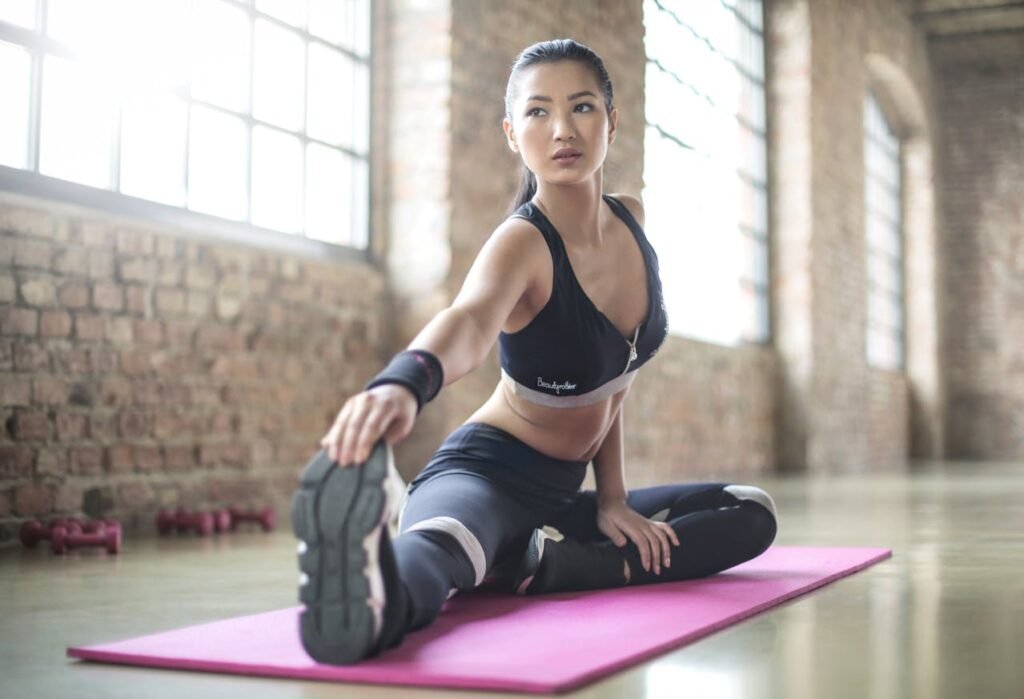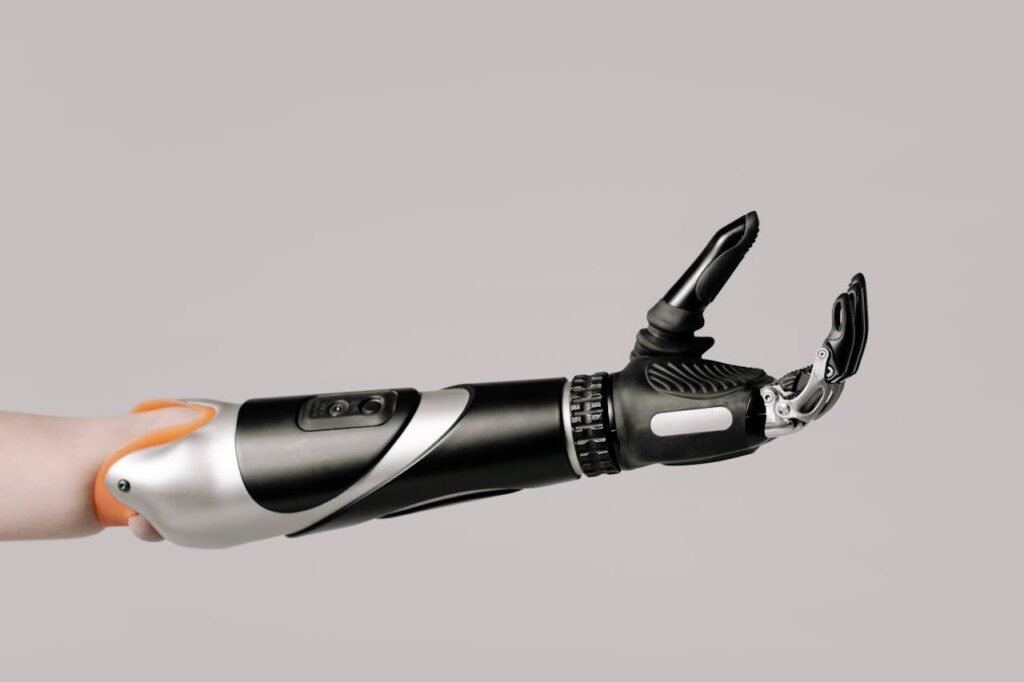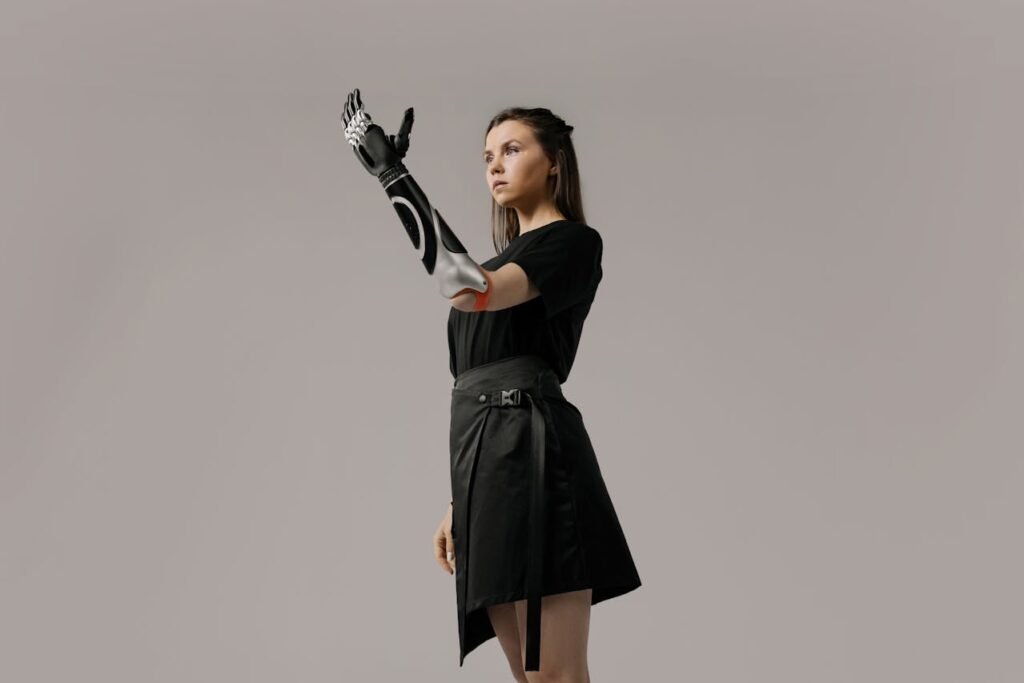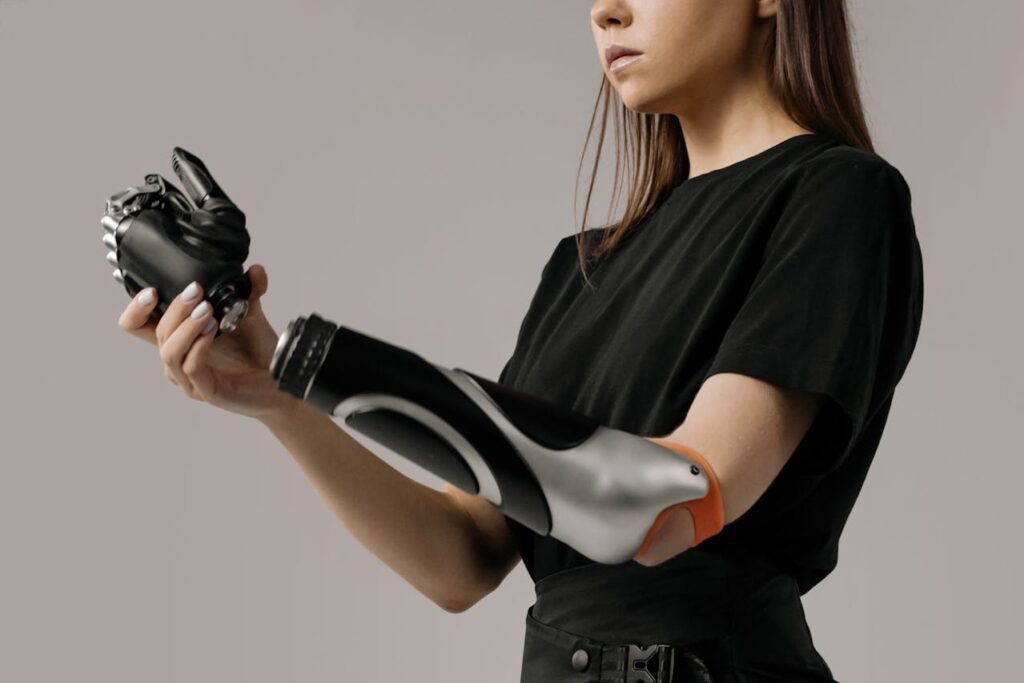Fitness means freedom. For many women using upper-limb prosthetics, returning to exercise—especially gym workouts or yoga—represents more than physical health. It’s a way to reclaim confidence, rebuild strength, and reconnect with the body. But it also brings questions.
How do you balance weights safely? Can yoga poses be modified? Will the prosthetic handle strain or sweat? These are valid worries that every woman faces when beginning her journey into fitness with a prosthetic hand or arm.
The good news is that with the right approach, both the gym and the yoga mat can become empowering spaces again. With smart adjustments and patience, you can achieve balance, flexibility, and strength—without risking comfort or control.
At Robobionics, we’ve helped many women across India rediscover fitness using upper-limb prosthetics. From lightweight body-powered models to advanced myoelectric hands, each design can be adapted for a fitness routine. This article is your detailed guide—covering practical workouts, safe yoga postures, and how to create a sustainable exercise routine built around your unique body and goals.
Preparing for Exercise – Building the Foundation of Safe Movement
Understanding Your Body and Prosthetic Together

Before beginning any gym or yoga routine, it’s important to first understand how your prosthetic interacts with your body. Each woman’s residual limb, muscle tone, and range of motion are different.
Your prosthetic hand or arm may support grip, balance, or even mild resistance, but the rest of your body compensates in subtle ways. This means that even gentle workouts require awareness of posture and muscle engagement.
Think of your prosthetic not as a replacement, but as an extension—one that works in partnership with your natural body rhythm.
Consulting with Professionals Before Starting
Before lifting weights or trying yoga poses, speak with your prosthetist and physiotherapist. They can help assess your limb’s condition, the socket fit, and the mechanical limits of your prosthetic.
A physiotherapist can also teach you warm-ups that strengthen shoulder and back muscles, helping to prevent strain. These early sessions create a foundation of safety and confidence.
For women who’ve recently started using a prosthetic, this step is crucial. Jumping straight into workouts without guidance can lead to uneven muscle development or discomfort around the socket.
Setting Realistic Fitness Goals
Your first goal should not be heavy lifting or advanced yoga postures—it should be control, stability, and comfort. Fitness is a gradual journey, and prosthetic users benefit most from consistent progress rather than intensity.
Start small. It may be five minutes of stretching one week, ten minutes of light resistance training the next. Every bit of progress strengthens not only your muscles but your trust in your prosthetic.
Remember, slow consistency always beats speed in building long-term fitness.
Choosing the Right Type of Prosthetic for Exercise
Not all prosthetic hands are built for the same purpose. For gym workouts, you may need a different attachment or grip system than what you use for daily tasks.
Some women prefer using interchangeable prosthetic hooks or silicone grips that allow better hold on gym equipment. Myoelectric users might choose a passive mode for stability during certain movements.
Your prosthetist can help design an attachment suited for your fitness goals—whether for yoga, weights, or general cardio. The right setup reduces strain and enhances comfort.
Warming Up for Stability and Balance
Warm-ups prepare your muscles and joints for motion, but for prosthetic users, they also help with alignment. Focus on slow, mindful movements that wake up the shoulders, core, and back.
Gentle rotations, shoulder rolls, and neck stretches are great starting points. You can add light arm circles using your prosthetic to improve symmetry.
These warm-ups help your body recognize balance and prevent fatigue during longer sessions. Even five minutes of warming up can change how secure and relaxed you feel.
Checking Fit Before Every Session
Before beginning any exercise, ensure your prosthetic is properly aligned. A small shift in socket position can lead to pressure buildup or skin irritation during activity.
If your prosthetic feels loose, remove and refit it before proceeding. Always check for signs of discomfort, redness, or pinching around your limb after workouts.
A comfortable fit ensures that your focus stays on your movement—not on adjusting your prosthetic mid-session.
The Importance of Core Strength
Your core—the muscles around your abdomen and lower back—is the center of all balance. For women using upper-limb prosthetics, a strong core helps offset the difference in weight between arms.
Simple exercises like seated leg lifts, bridges, and pelvic tilts can build stability without stressing your prosthetic. Once your core is strong, both gym training and yoga become easier and more enjoyable.
Every controlled movement you make begins from your core, not just your limbs.
Learning to Listen to Your Body
Fatigue feels different when using a prosthetic hand. Sometimes the prosthetic’s weight or the socket pressure can cause tiredness even when your muscles aren’t sore.
Pay attention to subtle signs—tightness, tingling, or unusual strain. Take breaks before exhaustion sets in. It’s better to rest early and resume strong than to push through discomfort and risk injury.
Your body always communicates what it needs. Listening to it keeps your progress safe and sustainable.
Gym Workouts for Strength and Endurance – Adaptations, Safety, and Training Plans
Redefining Strength Training with a Prosthetic

When women using upper-limb prosthetics step into the gym, the goal isn’t to compete with others—it’s to build strength that supports real life. Lifting grocery bags, maintaining posture, or typing comfortably are all small victories that gym training can enhance.
A gym routine doesn’t have to look like a typical one. You can customize each exercise to match your prosthetic’s design and your comfort level. The aim is balance—training your stronger side while gently building strength on the prosthetic side.
Progress in the gym is not measured by how much you lift but by how freely you move.
Selecting Gym Equipment Safely
The right equipment matters. Machines that offer guided movement—like seated rows, chest presses, and leg curls—are ideal starting points. They provide control, allowing you to focus on posture and form.
Free weights, on the other hand, require grip strength and stability. For prosthetic users, this may need modifications. Silicone sleeves, strap attachments, or custom grip tools can help you hold dumbbells securely.
Avoid exercises that require sudden or jerky pulling motions, especially when you’re still getting comfortable with your prosthetic. Smooth, controlled repetitions protect your joints and the socket fit.
Modifying Upper-Body Exercises
Upper-body exercises are essential, but they need adjustments. Instead of traditional pushups or pull-downs, start with modified resistance training.
Cable machines are excellent because you can adjust resistance precisely. Try unilateral movements—working one arm at a time—so each side develops independently and safely.
If your prosthetic doesn’t allow strong grip, use resistance bands instead. They’re flexible, light, and easy to anchor around stable points. You can perform curls, rows, and tricep extensions with minimal strain.
Even simple pushing and pulling actions help tone the shoulder girdle and upper back, which improves symmetry.
Focusing on the Core and Back
Your back and abdominal muscles support your entire upper body. Strengthening them gives you balance and reduces shoulder tension.
Machines like the lat pulldown or back extension can be customized to your prosthetic’s comfort. Keep resistance low in the beginning. Gradually, as your coordination improves, you can increase intensity.
If your prosthetic arm is non-functional, focus more on the natural arm for pulling actions while keeping your posture aligned. This prevents uneven strain across your shoulders.
Core workouts like planks or stability-ball exercises should emphasize form over duration. Even short holds can build endurance if done with precision.
Lower-Body Workouts for Overall Balance
Strong legs and glutes form the foundation of every fitness routine. For prosthetic users, leg training helps offset any imbalance caused by reduced arm mobility.
Squats, lunges, and leg presses are excellent for this purpose. Use your prosthetic for gentle counterbalance during bodyweight squats—it stabilizes posture without adding pressure.
Machines like the seated leg press or leg extension allow you to work your lower body safely while keeping your upper body supported.
Remember, lower-body strength also enhances balance during yoga and daily activities.
Building Endurance with Cardio
Cardio exercises improve stamina and energy levels, but not every machine suits everyone. Treadmills, elliptical trainers, and stationary bikes can all be adapted for your needs.
If your prosthetic has limited motion, focus on lower-body dominant machines. The elliptical provides full-body rhythm while letting your prosthetic move naturally.
For some, rowing machines are also effective. Just ensure your prosthetic grip attachment can handle continuous movement without strain.
Always start with shorter sessions—ten to fifteen minutes—and build up gradually. Endurance grows naturally when you stay consistent.
Balance and Posture Training
Good posture is key to both gym workouts and daily comfort. Many women unknowingly lean slightly toward their natural arm, especially during weights or treadmill use.
Focus on mirror-based exercises. Watching your reflection helps you notice subtle tilts or shifts in your body. Keep your shoulders even and spine tall.
Using stability balls, light weights, or balance boards can improve coordination between both sides of your body. These exercises train your muscles to distribute weight evenly—a big advantage during yoga or walking.
Breathing and Rhythm Control
Breathing is often overlooked in fitness routines, yet it directly affects energy and balance. Women using prosthetics benefit greatly from slow, rhythmic breathing that keeps the core engaged.
Exhale while exerting effort—like lifting a weight—and inhale while relaxing. This rhythm helps prevent stiffness and improves muscle coordination across the chest and back.
In cardio sessions, synchronize breathing with motion. It keeps your prosthetic side relaxed and prevents overcompensation by your natural arm.
Monitoring Grip and Pressure
Whether you’re holding a weight or using a machine, monitor how your prosthetic connects with the surface. If it feels slippery or loose, stop and adjust immediately.
Over time, your grip control improves naturally. You’ll learn how much pressure to apply without fatigue. But it’s essential to take breaks and avoid over-tightening the socket area.
If you use a myoelectric hand, sweat or moisture can affect sensor contact. Keep a towel handy and dry your limb periodically. Silicone or fabric liners with breathable designs help maintain comfort during longer workouts.
Cooling Down and Post-Gym Care
Cooling down is as important as warming up. Slow stretches and deep breathing relax your muscles and restore calmness. Focus on gentle movements for the shoulders, neck, and back to release tension.
After removing your prosthetic, clean the socket and your skin with a soft, damp cloth. Apply moisturizer to prevent dryness caused by sweat or friction.
A quick check for redness or soreness helps catch early signs of pressure points. If discomfort persists, consult your prosthetist before your next workout.
Confidence Through Consistency
The more you visit the gym, the more comfortable your movements become. Confidence doesn’t appear overnight—it’s built repetition by repetition.
You’ll start noticing how smoothly you shift weights, how your balance improves, and how your energy lasts longer. These changes reinforce your connection with your prosthetic, turning fitness into a celebration of ability, not limitation.
Every rep, every stretch, every breath becomes proof that your body adapts beautifully when guided with patience and awareness.
Yoga for Women with Upper-Limb Prosthetics – Flexibility, Balance, and Mindful Strength
The Spirit of Yoga with a Prosthetic

Yoga is more than movement—it’s connection. For women using upper-limb prosthetics, yoga offers a powerful way to reconnect with their body, rebuild flexibility, and rediscover calmness after years of adjustment.
Unlike gym training, yoga doesn’t depend on heavy resistance or fast motion. It focuses on awareness—of breath, alignment, and presence. That makes it especially empowering for prosthetic users who want to build confidence through mindful control.
The goal isn’t to achieve perfect poses. It’s to find harmony in how your body moves today and to celebrate progress over perfection.
Creating a Safe Space for Practice
Before beginning yoga at home or in a studio, create an environment that supports stability. Use a non-slip mat and, if needed, place it near a wall for support during balance postures.
Let your yoga instructor know about your prosthetic. A trained teacher can guide you in modifying poses to protect your shoulder and back alignment.
If you practice alone, start near a surface you can lightly touch with your natural hand—like a chair or table edge—so you can regain balance easily.
This setup allows you to explore yoga freely without fear of falling or straining your limb.
Preparing Your Body and Mind
A short pre-yoga routine helps ease your muscles and calm your mind. Take slow, deep breaths and gently rotate your shoulders. These small motions loosen your joints and warm your upper back.
Sit comfortably and take a minute to feel your prosthetic as part of your movement. The idea is to make the limb feel connected, not foreign.
Once you start seeing your prosthetic as part of your body’s rhythm, your confidence during yoga grows naturally.
Adapting Common Yoga Poses
Many classic yoga poses can be modified to suit your comfort level. Small changes in hand placement or arm extension make them fully accessible without reducing their benefits.
For example, Tadasana (Mountain Pose) can be practiced by focusing on alignment rather than arm height. Keep both arms relaxed by your sides instead of overhead. Focus on standing tall, grounding your feet, and lifting your chest gently.
In Virabhadrasana (Warrior Pose), you can keep the prosthetic arm slightly bent or resting on your thigh while maintaining focus on the leg and hip engagement. The strength and stability of this pose come from the lower body—not the arms.
Balance Poses and Modifications
Balance poses like Tree Pose (Vrikshasana) or Eagle Pose (Garudasana) can be adapted beautifully with a prosthetic.
If balance feels tricky, stand close to a wall or use your natural hand for light support. In Tree Pose, focus on grounding one leg firmly rather than lifting the other too high.
Balance improves with patience and breathing. Over time, your body automatically adjusts to your prosthetic’s weight distribution, and you’ll find stability becoming second nature.
Floor-Based Yoga for Flexibility
Floor postures are especially beneficial because they minimize balance concerns. Poses like Cat-Cow (Marjaryasana-Bitilasana), Seated Forward Bend (Paschimottanasana), or Cobra (Bhujangasana) improve flexibility and back strength.
If placing weight on the prosthetic feels uncomfortable, use a folded towel or cushion beneath it for support. This distributes pressure evenly and prevents slipping.
Some women prefer keeping their prosthetic off the mat during floor poses. You can rest it comfortably beside you and use your natural arm for movement. The essence of yoga lies in awareness, not symmetry.
Yoga for Shoulder and Back Health
The shoulder and upper back often work harder when using a prosthetic. Yoga can relieve tension by stretching these areas gently.
Seated Spinal Twists and Shoulder Openers done with controlled breathing release tightness around the socket area. Always move slowly and stop if you feel pulling or pressure near your residual limb.
You can also try gentle Bridge Pose (Setu Bandhasana) to strengthen your back muscles while expanding your chest. It supports posture and eases shoulder fatigue after long hours of prosthetic use.
Core-Centered Yoga Movements
Strong core muscles stabilize your spine and improve balance in every pose. For prosthetic users, core strength enhances control and reduces strain on the shoulders.
Simple postures like Boat Pose (Navasana), Plank Variations, or Leg Raises can be adapted easily. For example, during Plank Pose, you can rest your prosthetic forearm or use your natural hand for full support while keeping the prosthetic relaxed.
Even if you hold the pose for just a few breaths, the engagement it builds supports both your daily posture and overall strength.
Gentle Flow and Breathing Control
Yoga is not just movement—it’s flow. The transition between poses teaches grace and balance. Start with slow flows such as Cat-Cow to Child’s Pose or Seated Forward Bend to Butterfly Pose.
During each transition, focus on your breathing. Inhale to lengthen, exhale to relax. This rhythm keeps your body fluid and prevents stiffness in the prosthetic shoulder area.
Controlled breathing also steadies your heart rate and enhances endurance for longer sessions.
Pranayama for Calm and Focus
Breathing exercises, or pranayama, are central to yoga practice. They reduce anxiety, improve lung capacity, and promote focus—qualities that benefit every prosthetic user.
Begin with simple techniques like Anulom Vilom (Alternate Nostril Breathing) or Bhramari (Humming Bee Breath). Sit in a comfortable position with your spine upright and shoulders relaxed.
You can rest your prosthetic hand on your lap or thigh during these practices. The goal is inner calm, not posture perfection.
A few minutes of pranayama each day can make a noticeable difference in emotional balance and body awareness.
Meditation and Body Awareness
Meditation deepens your connection with your prosthetic and your body. It teaches patience and acceptance—two things that make every physical activity smoother.
Sit comfortably with eyes closed and focus on your breathing. Imagine energy moving evenly through both sides of your body. Feel how your prosthetic hand contributes to your sense of balance and completeness.
This practice slowly replaces hesitation with harmony. Over time, meditation becomes your quiet source of strength before or after physical workouts.
Ending the Session Mindfully
Every yoga session should end with relaxation. Lie in Shavasana (Corpse Pose), allowing your entire body to release tension.
Keep your prosthetic comfortably supported. Focus on slow, rhythmic breathing. Feel your heartbeat steadying and your mind settling into peace.
This closing moment is where healing happens—physically and emotionally. It reinforces that your body, in every form, is strong, adaptable, and graceful.
Creating Long-Term Fitness Routines – Motivation, Adaptation, and Confidence for Life
Building a Routine That Feels Natural

The most successful fitness routine is one that fits your life—not the other way around. When you’re using an upper-limb prosthetic, sustainability matters more than intensity.
Your body adapts best when movement becomes a daily rhythm rather than a weekly task. Whether it’s twenty minutes of yoga in the morning, or three short gym sessions a week, what matters most is consistency.
Choose times that feel natural—moments when your energy is highest. Some women prefer early mornings for yoga’s calmness, while others find evening gym workouts more refreshing after a busy day.
The more your routine feels like self-care rather than effort, the longer it will last.
Balancing Yoga and Gym Workouts
Yoga and gym routines complement each other beautifully. Strength training builds muscle tone and endurance, while yoga restores flexibility and relaxation.
You can alternate between the two—two days of yoga for mindfulness and posture, followed by two days of gym workouts for power and stability.
This rotation keeps your muscles challenged but never overworked. It also prevents boredom, which is one of the biggest reasons people abandon their fitness plans.
For prosthetic users, this balance ensures both physical and emotional well-being. You’ll feel grounded yet strong, flexible yet secure.
Listening to Your Body’s Cues
Progress in fitness isn’t measured by how heavy you lift or how deep your stretch is—it’s measured by how your body feels afterward.
If you wake up refreshed and energized, your routine is serving you well. If you feel constant soreness, fatigue, or socket discomfort, it’s time to adjust.
Your prosthetic may need realignment after several weeks of continuous workouts. Small shifts in your residual limb’s muscle tone can affect socket fit.
Don’t ignore these signs. Taking a short rest or visiting your prosthetist isn’t a setback—it’s part of maintaining long-term health.
Overcoming Mental Barriers
The biggest challenge in fitness often isn’t physical—it’s psychological. Many women hesitate to return to exercise after limb loss because they fear judgment, awkwardness, or failure.
But fitness spaces are changing. Gyms and yoga studios across India are becoming more inclusive and aware. You might be surprised how supportive instructors and fellow members can be once they see your determination.
Every woman who steps into a gym or unfolds a yoga mat with a prosthetic becomes a silent teacher—showing others that strength is not limited by anatomy.
The first few sessions may feel unfamiliar, but soon the focus shifts from how your arm looks to how amazing your body feels in motion.
Motivation That Lasts Beyond Goals
Setting goals is easy; staying motivated is harder. The secret is to link exercise with meaning, not just metrics.
Instead of chasing weight loss or muscle size, think of what fitness gives you daily—freedom, comfort, energy, and confidence.
Write down small victories: the first time you lifted a heavier dumbbell, held a yoga pose longer, or simply felt less self-conscious in class.
Celebrating these milestones keeps your motivation alive. It reminds you that fitness is not about the mirror—it’s about the journey back to self-trust.
Managing Sweat, Hygiene, and Prosthetic Care
Exercise increases sweat and friction, especially around the prosthetic socket. Good hygiene prevents discomfort and extends the life of your device.
Always wear a clean liner or sleeve before workouts. After each session, remove your prosthetic and clean your skin with a mild antibacterial wipe or soap.
Rinse the socket with a damp cloth and allow it to air dry completely before reattachment. If sweat buildup is frequent, use absorbent liners or talk to your prosthetist about breathable designs.
Regular maintenance ensures that both your body and your prosthetic stay in great condition as your training intensity grows.
Nutrition for Energy and Recovery
A balanced diet supports your fitness goals as much as the exercises themselves. Since upper-body workouts and yoga both engage multiple muscle groups, recovery nutrition is essential.
Include protein-rich foods like dal, paneer, eggs, or legumes to rebuild muscle. Add fruits, vegetables, and whole grains for energy and hydration.
Drinking enough water before and after workouts helps prevent fatigue and keeps your muscles supple. If you’re training in humid weather, electrolyte water can help maintain balance.
Healthy food doesn’t just fuel your body—it boosts your mood and keeps motivation high.
Building Confidence in Public Spaces
Stepping into a gym or yoga studio for the first time with a prosthetic can feel intimidating. But confidence is built through repetition and familiarity.
Start with smaller, quieter times of the day. Morning or mid-afternoon sessions are less crowded and more comfortable. As you grow confident, peak hours won’t bother you at all.
Wearing clothing that allows your prosthetic to move freely yet feels stylish can also boost your comfort level. Fitted activewear prevents fabric from catching on your prosthetic joints while helping you move naturally.
You’ll notice over time that people admire your effort far more than they notice your prosthetic.
Dealing with Setbacks
No fitness journey is without hurdles. Illness, socket adjustments, or temporary discomfort can interrupt your routine.
The key is to view setbacks as pauses, not endings. Use that time to focus on rest, stretching, or mindfulness. You can even do seated yoga or breathing exercises to stay connected to your routine.
Once your body feels ready again, ease back in slowly. Fitness is a lifelong relationship—temporary breaks don’t erase your progress.
Social Support and Community
Having supportive people around makes everything easier. Join online forums or local fitness groups where prosthetic users share their routines and experiences.
At Robobionics, we’ve seen how peer encouragement transforms confidence. When women share success stories or tips on adapting exercises, it reminds everyone that fitness is not about perfection—it’s about persistence.
If you have a friend who enjoys fitness, invite her to join your sessions. A familiar face turns workouts into something joyful and social, not just routine.
Customizing Yoga and Gym Days
Some weeks you may feel strong and energetic; others may call for rest and mindfulness. Allow flexibility in your schedule.
If you feel tightness around your shoulder or arm, replace a gym day with gentle yoga or breathing exercises. If you feel restless, switch to light cardio or dance-based workouts.
Adaptation keeps your mind fresh and prevents physical strain. The more intuitive your schedule becomes, the more natural exercise feels in your life.
Tracking Progress and Celebrating Wins
Track your improvement in small, meaningful ways. Write down your reps, stretches, or simply how your body feels after a session.
Some women take photos every few weeks—not for vanity, but as a reminder of transformation. Seeing visible progress strengthens motivation.
You can even record small personal milestones: a perfect yoga posture, lifting a weight without discomfort, or completing a class you once found intimidating.
Each milestone tells a story of strength, courage, and growth.
Emotional Healing Through Movement
Fitness isn’t only about muscles—it’s about healing. For many women, reconnecting with their bodies through yoga or gym workouts helps rebuild self-image after amputation.
Every session reminds you that your body, even changed, is capable of grace and power. The prosthetic doesn’t limit your movement—it enhances it.
Moments of mindfulness during yoga or endorphin rushes after workouts release emotional tension and boost mental health. Exercise becomes not just physical therapy but emotional empowerment.
Finding Joy in Movement
Exercise doesn’t have to be serious all the time. Fun activities like dance, swimming, or cycling (if your prosthetic allows) can add variety and joy.
When fitness feels enjoyable, it stops being a task and becomes part of your identity. Many women using prosthetics rediscover forgotten hobbies once their confidence grows—like hiking, trekking, or even sports.
The more joy you associate with movement, the longer it stays part of your life.
Long-Term Care for Prosthetics Used in Fitness
Prosthetic maintenance is an ongoing process, especially if you’re active. Regularly check your socket fit and glove surface for signs of wear.
Sweat, friction, and repeated pressure during workouts can loosen parts over time. Schedule quarterly inspections with your prosthetist to keep everything performing smoothly.
Using prosthetic-safe lubricants or silicone conditioners maintains flexibility and prevents cracks in the outer glove.
Just like you take care of your muscles through rest and diet, your prosthetic deserves the same attention to stay reliable and strong.
Future of Fitness for Prosthetic Users in India
India is seeing a quiet revolution in inclusive fitness. More gyms are adopting adaptive equipment, and more trainers are learning how to guide prosthetic users safely.
Manufacturers like Robobionics are designing prosthetics with specific fitness attachments—grips for gym bars, flexible wrist joints for yoga, and lightweight materials for endurance.
The goal is simple: to make exercise accessible and joyful for every woman, regardless of her limb difference. The future is not just inclusive—it’s inspiring.
Final Thoughts
Gym and yoga routines for women with upper-limb prosthetics aren’t about limitations—they’re about rediscovering strength, grace, and balance. Every repetition, stretch, and breath is a reminder that your body’s possibilities are endless.
You learn patience through slow progress, discipline through routine, and pride through every breakthrough.
At Robobionics, we’ve seen that true empowerment doesn’t come from technology alone—it comes from the spirit that uses it. The prosthetic is just a bridge; your determination is the real power behind it.
So step into the gym, unroll that yoga mat, breathe deeply, and move freely. Your body knows the rhythm. Your mind sets the tone. And your prosthetic? It follows your lead—strong, capable, and uniquely yours.



